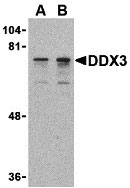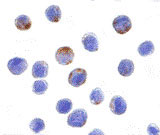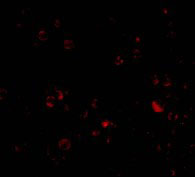DDX3 Antibody
- SPECIFICATION
- CITATIONS
- PROTOCOLS
- BACKGROUND

Application
| WB, IF, ICC, E |
|---|---|
| Primary Accession | O00571 |
| Other Accession | AAC34298, 3523150 |
| Reactivity | Human, Mouse |
| Host | Rabbit |
| Clonality | Polyclonal |
| Isotype | IgG |
| Calculated MW | 73243 Da |
| Application Notes | DDX3 antibody can be used for the detection of DDX3 by Western blot at 0.5 - 1 µg/mL. Antibody can also be used for immunocytochemistry starting at 10 µg/mL. For immunofluorescence start at 20 µg/mL. |
| Gene ID | 1654 |
|---|---|
| Other Names | DDX3 Antibody: DBX, DDX3, HLP2, DDX14, DBX, ATP-dependent RNA helicase DDX3X, DEAD box protein 3, X-chromosomal, DEAD (Asp-Glu-Ala-Asp) box polypeptide 3, X-linked |
| Target/Specificity | DDX3X; DDX3 antibody will detect both DDX3 and DBY. |
| Reconstitution & Storage | DDX3 antibody can be stored at 4℃ for three months and -20℃, stable for up to one year. As with all antibodies care should be taken to avoid repeated freeze thaw cycles. Antibodies should not be exposed to prolonged high temperatures. |
| Precautions | DDX3 Antibody is for research use only and not for use in diagnostic or therapeutic procedures. |
| Name | DDX3X |
|---|---|
| Synonyms | DBX {ECO:0000303|PubMed:15294876}, DDX3 |
| Function | Multifunctional ATP-dependent RNA helicase (PubMed:17357160, PubMed:21589879, PubMed:31575075). The ATPase activity can be stimulated by various ribo-and deoxynucleic acids indicative for a relaxed substrate specificity (PubMed:29222110). In vitro can unwind partially double-stranded DNA with a preference for 5'-single-stranded DNA overhangs (PubMed:17357160, PubMed:21589879). Binds RNA G- quadruplex (rG4s) structures, including those located in the 5'-UTR of NRAS mRNA (PubMed:30256975). Involved in many cellular processes, which do not necessarily require its ATPase/helicase catalytic activities (Probable). Involved in transcription regulation (PubMed:16818630, PubMed:18264132). Positively regulates CDKN1A/WAF1/CIP1 transcription in an SP1-dependent manner, hence inhibits cell growth. This function requires its ATPase, but not helicase activity (PubMed:16818630, PubMed:18264132). CDKN1A up-regulation may be cell-type specific (PubMed:18264132). Binds CDH1/E-cadherin promoter and represses its transcription (PubMed:18264132). Potentiates HNF4A-mediated MTTP transcriptional activation; this function requires ATPase, but not helicase activity. Facilitates HNF4A acetylation, possibly catalyzed by CREBBP/EP300, thereby increasing the DNA-binding affinity of HNF4 to its response element. In addition, disrupts the interaction between HNF4 and SHP that forms inactive heterodimers and enhances the formation of active HNF4 homodimers. By promoting HNF4A-induced MTTP expression, may play a role in lipid homeostasis (PubMed:28128295). May positively regulate TP53 transcription (PubMed:28842590). Associates with mRNPs, predominantly with spliced mRNAs carrying an exon junction complex (EJC) (PubMed:17095540, PubMed:18596238). Involved in the regulation of translation initiation (PubMed:18628297, PubMed:17667941, PubMed:22872150). Not involved in the general process of translation, but promotes efficient translation of selected complex mRNAs, containing highly structured 5'-untranslated regions (UTR) (PubMed:20837705, PubMed:22872150). This function depends on helicase activity (PubMed:20837705, PubMed:22872150). Might facilitate translation by resolving secondary structures of 5'-UTRs during ribosome scanning (PubMed:20837705). Alternatively, may act prior to 43S ribosomal scanning and promote 43S pre-initiation complex entry to mRNAs exhibiting specific RNA motifs, by performing local remodeling of transcript structures located close to the cap moiety (PubMed:22872150). Independently of its ATPase activity, promotes the assembly of functional 80S ribosomes and disassembles from ribosomes prior to the translation elongation process (PubMed:22323517). Positively regulates the translation of cyclin E1/CCNE1 mRNA and consequently promotes G1/S-phase transition during the cell cycle (PubMed:20837705). May activate TP53 translation (PubMed:28842590). Required for endoplasmic reticulum stress-induced ATF4 mRNA translation (PubMed:29062139). Independently of its ATPase/helicase activity, enhances IRES-mediated translation; this activity requires interaction with EIF4E (PubMed:17667941, PubMed:22323517). Independently of its ATPase/helicase activity, has also been shown specifically repress cap- dependent translation, possibly by acting on translation initiation factor EIF4E (PubMed:17667941). Involved in innate immunity, acting as a viral RNA sensor. Binds viral RNAs and promotes the production of type I interferon (IFN-alpha and IFN-beta) (PubMed:31575075, PubMed:20127681, PubMed:21170385). Potentiate MAVS/RIGI-mediated induction of IFNB in early stages of infection (PubMed:20127681, PubMed:21170385). Enhances IFNB1 expression via IRF3/IRF7 pathway and participates in NFKB activation in the presence of MAVS and TBK1 (PubMed:18583960, PubMed:18636090, PubMed:21170385, PubMed:27980081, PubMed:19913487). Involved in TBK1 and IKBKE-dependent IRF3 activation leading to IFNB induction, acts as a scaffolding adapter that links IKBKE and IRF3 and coordinates their activation (PubMed:23478265). Involved in the TLR7/TLR8 signaling pathway leading to type I interferon induction, including IFNA4 production. In this context, acts as an upstream regulator of IRF7 activation by MAP3K14/NIK and CHUK/IKKA. Stimulates CHUK autophosphorylation and activation following physiological activation of the TLR7 and TLR8 pathways, leading to MAP3K14/CHUK-mediated activatory phosphorylation of IRF7 (PubMed:30341167). Also stimulates MAP3K14/CHUK-dependent NF-kappa-B signaling (PubMed:30341167). Negatively regulates TNF-induced IL6 and IL8 expression, via the NF-kappa-B pathway. May act by interacting with RELA/p65 and trapping it in the cytoplasm (PubMed:27736973). May also bind IFNB promoter; the function is independent of IRF3 (PubMed:18583960). Involved in both stress and inflammatory responses (By similarity). Independently of its ATPase/helicase activity, required for efficient stress granule assembly through its interaction with EIF4E, hence promotes survival in stressed cells (PubMed:21883093). Independently of its helicase activity, regulates NLRP3 inflammasome assembly through interaction with NLRP3 and hence promotes cell death by pyroptosis during inflammation. This function is independent of helicase activity (By similarity). Therefore DDX3X availability may be used to interpret stress signals and choose between pro-survival stress granules and pyroptotic NLRP3 inflammasomes and serve as a live-or-die checkpoint in stressed cells (By similarity). In association with GSK3A/B, negatively regulates extrinsic apoptotic signaling pathway via death domain receptors, including TNFRSF10B, slowing down the rate of CASP3 activation following death receptor stimulation (PubMed:18846110). Cleavage by caspases may inactivate DDX3X and relieve the inhibition (PubMed:18846110). Independently of its ATPase/helicase activity, allosteric activator of CSNK1E. Stimulates CSNK1E-mediated phosphorylation of DVL2, thereby involved in the positive regulation of Wnt/beta-catenin signaling pathway. Also activates CSNK1A1 and CSNK1D in vitro, but it is uncertain if these targets are physiologically relevant (PubMed:23413191, PubMed:29222110). ATPase and casein kinase-activating functions are mutually exclusive (PubMed:29222110). May be involved in mitotic chromosome segregation (PubMed:21730191). |
| Cellular Location | Cell membrane. Nucleus. Cytoplasm. Cytoplasm, Stress granule. Inflammasome {ECO:0000250|UniProtKB:Q62167}. Cell projection, lamellipodium. Cytoplasm, cytoskeleton, microtubule organizing center, centrosome Note=Shuttles between the nucleus and the cytosol (PubMed:15507209, PubMed:18636090, PubMed:29899501, PubMed:31575075, PubMed:30131165) Exported from the nucleus partly through the XPO1/CRM1 system and partly through NXF1/TAP (PubMed:15507209, PubMed:18636090, PubMed:18596238, PubMed:31575075, PubMed:30131165). Localizes to nuclear pores on the outer side of the nuclear membrane (PubMed:15507209). In the cytosol, partly colocalizes with mitochondria (PubMed:20127681). At G0, predominantly located in nucleus. In G1/S phase, predominantly cytoplasmic (PubMed:22034099). During prophase/prometaphase, localizes in close proximity to the condensing chromosomes (PubMed:30131165, PubMed:21730191). During telophase, localizes around the newly synthesized nuclear membrane and in the cytoplasm (PubMed:22034099). Colocalizes with TRPV4 at the plasma membrane. When TRPV4 channel is activated, intracellular Ca(2+) levels increase and the calmodulin/CAMKII pathway is activated, relocalizes to the nucleus (PubMed:29899501). WNT3A stimulation promotes DDX3 recruitment to the plasma membrane (PubMed:23413191). At the leading edge of migrating fibroblasts, colocalizes with CAPRIN1 and PABPC1 (PubMed:28733330). Localizes to centrosome throughout the cell cycle and associates with TP53 at centrosome during mitosis (PubMed:28842590). Translocates to the nucleus in response to HPIV-3 virus-mediated infection (PubMed:31575075) |
| Tissue Location | Widely expressed (PubMed:15294876). In testis, expressed in spermatids (PubMed:15294876). Expressed in epidermis and liver (at protein level) (PubMed:16818630, PubMed:16301996) |

Thousands of laboratories across the world have published research that depended on the performance of antibodies from Abcepta to advance their research. Check out links to articles that cite our products in major peer-reviewed journals, organized by research category.
info@abcepta.com, and receive a free "I Love Antibodies" mug.
Provided below are standard protocols that you may find useful for product applications.
Background
DDX3 Antibody: DDX3 contains all of the motifs of the DEAD-box family of RNA helicases, including the Asp-Glu-Ala-Asp sequence that gives the protein family its name and distinguishes it from other RNA helicases. DDX3 is localized to the X chromosome and has a highly conserved functional homolog (DBY) on the Y chromosome. DDX3 is thought to be involved in RNA splicing, RNA transport, and translation initiation. It has also been shown to be involved in cell growth control and is deregulated in hepatitis virus-associated hepatocellular carcinoma. Recent experiments suppressing DDX3 expression blocked HIV-1 RNA export from the nucleus, suggesting that DDX3 functions as a shuttling protein that transports the HIV-1 protein Rev and its cofactor CRM1 from the nucleus to the cytoplasm.
References
Linder P, Lasko PF, Ashburner M, et al. Birth of the D-E-A-D box. Nature 1989; 337:121-2.
Park SH, Lee SG, Kim Y, et al. Assignment of a human putative RNA helicase gene, DDX3, to human X chromosome bands p11.3-->p11.23. Cytogenet. Cell Genet. 1998; 81:178-9.
Lahn BT and Page DC. Functional coherence of the human Y chromosome. Science 1997; 278:675-80.
Abdelhaleem M. RNA helicases: regulators of differentiation. Clin. Biochem. 2005; 38:499-503.
If you have used an Abcepta product and would like to share how it has performed, please click on the "Submit Review" button and provide the requested information. Our staff will examine and post your review and contact you if needed.
If you have any additional inquiries please email technical services at tech@abcepta.com.













 Foundational characteristics of cancer include proliferation, angiogenesis, migration, evasion of apoptosis, and cellular immortality. Find key markers for these cellular processes and antibodies to detect them.
Foundational characteristics of cancer include proliferation, angiogenesis, migration, evasion of apoptosis, and cellular immortality. Find key markers for these cellular processes and antibodies to detect them. The SUMOplot™ Analysis Program predicts and scores sumoylation sites in your protein. SUMOylation is a post-translational modification involved in various cellular processes, such as nuclear-cytosolic transport, transcriptional regulation, apoptosis, protein stability, response to stress, and progression through the cell cycle.
The SUMOplot™ Analysis Program predicts and scores sumoylation sites in your protein. SUMOylation is a post-translational modification involved in various cellular processes, such as nuclear-cytosolic transport, transcriptional regulation, apoptosis, protein stability, response to stress, and progression through the cell cycle. The Autophagy Receptor Motif Plotter predicts and scores autophagy receptor binding sites in your protein. Identifying proteins connected to this pathway is critical to understanding the role of autophagy in physiological as well as pathological processes such as development, differentiation, neurodegenerative diseases, stress, infection, and cancer.
The Autophagy Receptor Motif Plotter predicts and scores autophagy receptor binding sites in your protein. Identifying proteins connected to this pathway is critical to understanding the role of autophagy in physiological as well as pathological processes such as development, differentiation, neurodegenerative diseases, stress, infection, and cancer.




